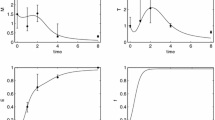Abstract
Wound healing is a complex biological process which involves many cell types and biochemical signals and which progresses through multiple, overlapping phases. In this manuscript, we develop a model of collagen accumulation as a marker of wound healing. The mathematical model is a system of ordinary differential equations which tracks fibroblasts, collagen, inflammation and pathogens. The model was validated by comparison to the normal time course of wound healing where appropriate activity for the inflammatory, proliferative and remodeling phases was recorded. Further validation was made by comparison to collagen accumulation experiments by Madden and Peacock (Ann. Surg. 174(3):511–520, 1971). The model was then used to investigate the impact of local oxygen levels on wound healing. Finally, we present a comparison of two wound healing therapies, antibiotics and increased fibroblast proliferation. This model is a step in developing a comprehensive model of wound healing which can be used to develop and test new therapeutic treatments.












Similar content being viewed by others
References
Almeida, L., Bagnerini, P., Habbal, A., Noselli, S., & Serman, F. (2011). A mathematical model for dorsal closure. J. Theor. Biol., 268(1), 105–119. doi:10.1016/j.jtbi.2010.09.029.
Ballard, J. L., Eke, C. C., Bunt, T. J., & Killeen, J. D. (1995). A prospective evaluation of transcutaneous oxygen measurements in the management of diabetic foot problems. Vasc. Surg., 22, 485–490.
Buckley, C. D., Pilling, D., Lord, J. M., Akbar, A. N., Scheel-Toellner, D., & Salmon, M. (2001). Fibroblasts regulate the switch from acute resolving to chronic persistent inflammation. Trends Immunol., 22(4), 199–204.
Caselli, A., Latini, V., Lapenna, A., Di Carlo, S., Pirozzi, F., Benvenuto, A., & Uccioli, L. (2005). Transcutaneous oxygen tension monitoring after successful revascularization in diabetic patients with ischaemic foot ulcers. Diabet. Med., J. Br. Diabet. Assoc., 22(4), 460–465. doi:10.1111/j.1464-5491.2005.01446.x.
Diegelmann, R. F., & Evans, M. C. (2004). Wound healing: an overview of acute, fibrotic and delayed healing. Front. Biosci., 9(1–3), 283. doi:10.2741/1184.
Eming, S. A., Krieg, T., & Davidson, J. M. (2000). Inflammation in wound repair: molecular and cellular mechanisms. J. Invest. Dermatol., 127(3), 514–525.
Flegg, J. A., Byrne, H. M., & McElwain, L. S. (2010). Mathematical model of hyperbaric oxygen therapy applied to chronic diabetic wounds. Bull. Math. Biol., 72(7), 1867–1891. doi:10.1007/s11538-010-9514-7.
Friedman, A., Hu, B., & Xue, C. (2010). Analysis of a mathematical model of ischemic cutaneous wounds. SIAM J. Math. Anal., 42(5), 2013–2040. doi:10.1137/090772630.
Goldberg, S. R., & Diegelmann, R. F. (2010). Wound healing primer. Surg. Clin. North Am., 90(6), 1133–1146. doi:10.1016/j.suc.2010.08.003.
Greenhalgh, D. G. (1998). The role of apoptosis in wound healing. Int. J. Biochem. Cell Biol., 30(9), 1019–1030. doi:10.1016/S1357-2725(98)00058-2.
Grinnell (1994). Fibroblasts, myofibroblasts, and wound contraction. J. Cell Biol., 124(4), 401–404.
Harley, C. B., Futcher, A. B., & Greider, C. W. (1990). Telomeres shorten during ageing of human fibroblasts. Nature, 345(6274), 458–460. doi:10.1038/345458a0.
Javierre, E., Vermolen, F. J., Vuik, C., & van der Zwaag, S. (2009). A mathematical analysis of physiological and morphological aspects of wound closure. J. Math. Biol., 59(5), 605–630. doi:10.1007/s00285-008-0242-7.
Kuehn, B. M. (2007). Chronic wound care guidelines issued. JAMA J. Am. Med. Assoc., 297(9), 938–939. doi:10.1001/jama.297.9.938.
Kühne, H. H., Ullmann, U., & Kühne, F. W. (1985). New aspects on the pathophysiology of wound infection and wound healing—the problem of lowered oxygen pressure in the tissue. Infection, 13(2), 52–56.
London, N. J. M., & Donnelly, R. (2000). Ulcerated lower limb. Br. Med. J., 320(7249), 1589–1591. doi:10.1136/bmj.320.7249.1589.
Madden, J. W., & Peacock, E. E. (1971). Studies on the biology of collagen during wound healing, 3: dynamic metabolism of scar collagen and remodeling of dermal wounds. Ann. Surg., 174(3), 511–520.
Martin, P., & Leibovich, S. J. (2005). Inflammatory cells during wound repair: the good, the bad and the ugly. Trends Cell Biol., 15(11), 599–607. doi:10.1016/j.tcb.2005.09.002.
Menke, N. B., Cain, J. W., Reynolds, A., Chan, D. M., Segal, R. A., Witten, T. M., Bonchev, D. G., Diegelmann, R. F., & Ward, K. R. (2010). An in silico approach to the analysis of acute wound healing. Wound Repair Regen., 18(1), 105–113. doi:10.1111/j.1524-475X.2009.00549.x.
Menke, N. B., Ward, K. R., Witten, T. M., Bonchev, D. G., & January, R. F. D. (2006) Impaired wound healing. Clin. Dermatol., 25(1), 19–25. doi:10.1016/j.clindermatol.2006.12.005.
Paulsen, F., Pufe, T., Conradi, L., Varoga, D., Tsokos, M., Papendieck, J., & Petersen, W. (2002). Antimicrobial peptides are expressed and produced in healthy and inflamed human synovial membranes. J. Pathol., 198(3), 369–377. doi:10.1002/path.1224.
Raj, P. A., & Dentino, A. R. (2002). Current status of defensing and their role in innate and adaptive immunity. FEMS Microbiol. Lett., 206(1), 9–18. 2. doi:10.1016/S0378-1097(01)00496-7.
Reynolds, A., Rubin, J., Clermont, G., Day, J., & Ermentrout, G. B. (2006). A reduced mathematical model of the acute inflammatory, I: derivation of model and analysis of anti-inflammation. J. Theor. Biol., 242(1), 220–236. doi:10.1016/j.jtbi.2006.02.016.
Ross, R. (1968). The fibroblast and wound repair. Biol. Rev., 43(1), 51–91. doi:10.1111/j.1469-185X.1968.tb01109.x.
Schilling, J. A. (1968). Wound healing. Physiol. Rev., 48(2), 374–423.
Sherratt, J. A., & Dallon, J. C. (2002). Theoretical models of wound healing: past successes and future challenges. C. R. Biol., 325(5), 557–567.
Smith, R. S., Smith, T. J., Blieden, T. M., & Phipps, R. P. (1997). Fibroblasts as sentinel cells. Synthesis of chemokines and regulation of inflammation. Am. J. Pathol., 151(2), 317–322.
Stefanini, M. O., Th Wu, F., Gabhann, F. M., & Popel, A. S. (2008). A compartment model of VEGF distribution in blood, healthy and diseased tissues. BMC Syst. Biol., 2, 19. doi:10.1186/1752-0509-2-77.
Takai, Y., Miyoshi, J., Ikeda, W., & Ogita, H. (2008). Nectins and nectin-like molecules: roles in contact inhibition of cell movement and proliferation. Nat. Rev. Mol. Cell Biol., 9(8), 603–615. doi:10.1038/nrm2457.
Turner, L., Scotton, C., Negus, R., & Balkwill, F. (1999). Hypoxia inhibits macrophage migration. Eur. J. Immunol., 29, 2280–2287.
Author information
Authors and Affiliations
Corresponding author
Rights and permissions
About this article
Cite this article
Segal, R.A., Diegelmann, R.F., Ward, K.R. et al. A Differential Equation Model of Collagen Accumulation in a Healing Wound. Bull Math Biol 74, 2165–2182 (2012). https://doi.org/10.1007/s11538-012-9751-z
Received:
Accepted:
Published:
Issue Date:
DOI: https://doi.org/10.1007/s11538-012-9751-z




